
An API, short for Application Programming Interface, is a set of rules and protocols that allows software products to communicate with each other. Within the insurance industry, they are employed to streamline processes, enhance data access, and boost business innovation. APIs ensure the opportunity for insurers to create personalized policyholders’ experiences, raise efficiency, and stay compliant with the dynamic regulations, all while reducing costs. Therefore, by having specific third-party APIs integrated, insurance companies can remain competitive in a rapidly changing landscape and provide enhanced value to their customers.
As we delve into the industry, custom API integration services become increasingly valuable to extend the business and enrich the diversity of services for customers.
In this article, we will uncover the way APIs are affecting the insurance industry, as well as define how they equip companies with the power of real-time data, automate workflows, and enhance decision-making.
Table of Contents:
Why Having Integrations is Crucial in the Insurance Sector
Efficient policyholder catering necessitates a strategic approach to data and service delivery, which makes it important to keep track of user data. For this, third-party integration is essential, offering insurers the ability to apply external resources, technologies, and expertise to enhance their operations.
In the Robot Factory project for Quandri, we integrated APIs for document processing and policy management, automating tasks like document renaming and policy matching. Similarly, in our Santé.app project, we leveraged APIs like Pipedrive and Twilio to synchronize customer interactions and enable appointment scheduling. These practical applications showcase how insurance APIs, when effectively integrated, can streamline operations, enhance customer experience, and deliver real-time insights across platforms.
Data Enrichment and Accuracy
Third-party data sources can provide insurers with valuable information to extend their customer profiles and underwriting processes. The integration of external data, such as credit scores, weather patterns, medical records, or even social media insights, can help insurers build more relevant serving strategies. Besides, insurance API integration and data analysis ensure the best practices for risk assessment, pricing accuracy, and more client-oriented policyholders’ journeys.
Speed and Efficiency
Accelerated service delivery is what truly matters in standing out from the crowded insurance market. Third-party integrations allow insurance businesses to access specialized services like instant claims processing, automated underwriting, and data analytics. The benefits such services bring are faster claim verification and processing and reduced manual workloads while ensuring that policyholders are delivered with second-per-second responses to their queries, ultimately enhancing satisfaction and loyalty.
Innovation and Customer-Centricity
The insurance industry is striving to shift towards customer-centric services. By integrating with Insurtech startups and technology providers, insurance companies can offer innovative services like telematics for personalized pricing, AI-based assistants for customer support, and mobile apps for policy management. This ensures policyholders have high transparency and convenient interactions with their insurers. An example of a solution that delivers high user orientation is Lemonade Insurance’s AI-based bot for client support. It is a cutting-edge virtual assistant designed to deliver instant and personalized assistance to policyholders. Based on AI, it rapidly handles user requests, guides clients through the insurance process, and offers a seamless, 24/7 customer support experience.
Regulatory Compliance
The regulatory sector doesn’t stand still, and insurers must adapt to stay compliant to operate legally and securely. API for insurance interconnecting with compliance experts and legal databases helps navigate and adhere to complex regulatory requirements, which include the Dodd-Frank Act, Affordable Care Act, Nonadmitted and Reinsurance Reform Act, more effectively. This eliminates the risk of fines and establishes the trust of policyholders in their insurers.
Cost Efficiency
Investing in building proprietary solutions can be costly and time-consuming. Third-party integrations often provide cost-effective, ready-made solutions that can be quickly deployed. This approach cuts down development costs and allows insurers to allocate resources more efficiently to areas that directly impact their customers.
The Power of Data Integration
Learn how seamless data integration can revolutionize your insurance business.
Types of Insurance APIs
Insurance APIs are integral to accelerating the industry’s progress. They are the digital connectors that allow insurers to streamline their operations, offer more personalized services, and enhance customer experiences. Let’s delve into four pivotal categories of insurance APIs, each with its unique use cases and real-life examples.
 Policy Management
Policy Management
Policy management APIs in insurance are the core of essential operations, allowing companies to handle policy-related tasks efficiently. These APIs facilitate policy creation, updates, and renewals. They provide seamless access to policy details, enhancing customer service as well.
Benefits of Policy Management API
Insurers can use policy management APIs to update policy information in real-time, ensuring instant accuracy and compliance. For example, in the context of life insurance, policy management APIs enable insurers to swiftly update beneficiaries’ information or adjust coverage details, ensuring that policyholders’ vital data remains current and compliant with their evolving needs. Moreover, such APIs can automate the renewal process, decreasing administrative work and ensuring policies remain active.
Claims Processing
Claims APIs can significantly improve the efficiency of claim submissions, assessments, and payouts. They enable insurers to streamline the entire claims workflow, from initial reporting to final settlements.
Claims Processing API benefits
With digital claims submission, policyholders are able to employ a user-friendly web app to report a claim. It is then processed through an API in the insurance industry. To illustrate, Lemonade leverages AI to handle claims via a chatbot. Aside from that, claims processing APIs can integrate with external fraud detection services to point out suspicious claims as early as possible in the process, enhancing cost management and trust.
Quote Generation
Quote generation APIs enable insurers to provide quick and accurate price estimates to potential customers. These APIs integrate with underwriting engines, rating algorithms, and data sources to deliver real-time quotes.
Veruna and Applied Systems API incorporate such capabilities, offering a range of insurance software solutions, covering quote generation tools that are used by insurance brokers and agencies. For example, when customers input their insurance information online, the API calculates personalized quotes in real time; Esurance offers a quote engine on its website. APIs also facilitate quoting on broker platforms, enabling brokers to provide accurate quotes to clients.
Customer Information
Data integration for insurance enhances the comprehension of the policyholders. These APIs connect to external data sources to get a precise view of customer profiles, covering financial data, credit scores, and other relevant information.
For example, LexisNexis provides various APIs that extract comprehensive data, covering credit scores, financial histories, and other relevant information, to assess risk and personalize insurance policies. It brings insurance companies with the capabilities related to personalization. Using customer information APIs, insurers can tailor policy recommendations based on an individual’s credit score and financial history. Moreover, customer information APIs can provide insight into a customer’s financial stability, aiding in risk assessment.
How to Get Started with Insurance APIs: a Strategic Roadmap
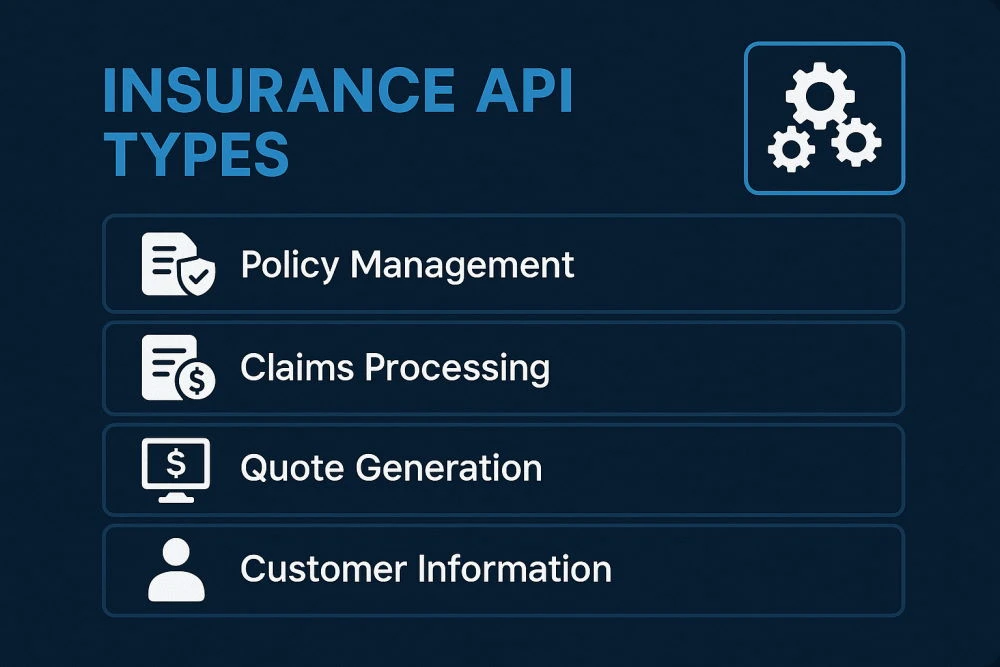 API in insurance holds the key to enhancing operational efficiency, providing more personalized services to policyholders, and improving their satisfaction. To elevate the customers’ roadmap with APIs and get all the benefits of digital transformation in Insurance, you should accomplish the following steps:
API in insurance holds the key to enhancing operational efficiency, providing more personalized services to policyholders, and improving their satisfaction. To elevate the customers’ roadmap with APIs and get all the benefits of digital transformation in Insurance, you should accomplish the following steps:
Identify Business Goals and Objectives
Before diving into API integration, it’s essential to define clear insurance company objectives and purposes. To achieve this, you should define the areas that require API-powered optimization. In practice, APIs can help streamline claims processing, elevate underwriting accuracy, or enhance customer interactions. Therefore, having well-defined pain points and fields for improvement is crucial.
Choose the Right API Providers
Selecting the right API provider for insurance digital transformation is a highly significant decision. Strive to set up a partnership with an agency that possesses strong commercial experience in custom API integration services, creating and offering solutions that align with your business goals. It’s critical to ensure that their APIs are compliant with industry regulations and capable of scaling as your needs rise.
Choose the Right Development Partner
In many cases, working with a development partner can expedite the integration process. Choose a vendor with in-depth expertise in insurance technology and a history of successful API integrations. They can help you seamlessly handle the complexities of integrating APIs and ensure a seamless implementation.
Need Custom Insurance Solutions?
Our experts can help you integrate powerful APIs for streamlined operations and a better customer experience.
Testing and Quality Assurance
Comprehension testing and quality assurance are the ways to ensure that your API integration performs as was primarily expected. It is essential for data accuracy, security, and performance under different real-world cases. This step helps identify and liquidate issues before they impact your operations or policyholders’ experiences.
Monitoring and Continuous Improvement
Once your APIs are integrated, establish a robust monitoring system. Regularly track API performance, data accuracy, and customer satisfaction. This ongoing monitoring allows you to identify areas for improvement, make necessary adjustments, and adapt to evolving customer needs.
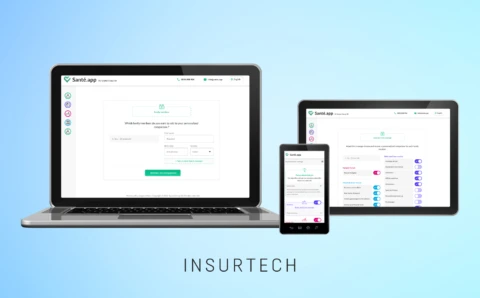
Santé.app
Our innovative Santé.app streamlines health insurance selection through surveys, offering users a quick, easy way to compare insurance options.
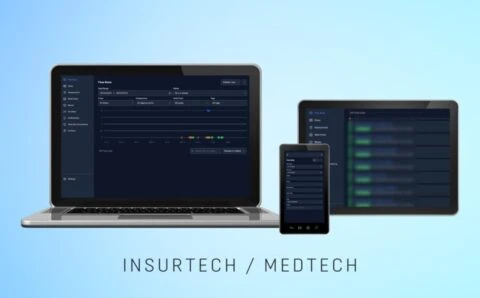
AI Platform
We created an AI-Assisted platform that automates and enhances admin processes, resulting in increased efficiency and superior patient service.
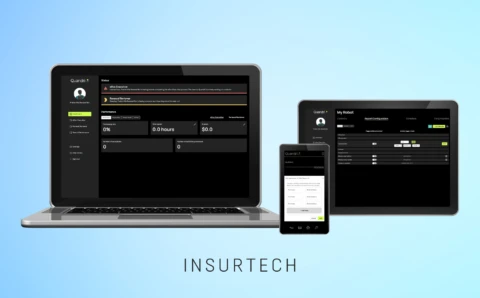
Robot Factory
Robot Factory empowers insurance brokers with automation, providing a platform for efficient document management and faster workflows.
Future Trends in Insurance APIs
As the industry continues to evolve, the role of API for insurance companies has the potential to change the sector by leveraging booming technologies, the latest trends, and tendencies. It’s time to explore the future of API security, client experience, and insurance digital transformation trends that are set to define the industry.
AI and Machine Learning Integration
The integration of AI and machine learning into insurance APIs has a wide range of use cases. These technologies offer the ability to process huge amounts of data faster, allowing real-time underwriting and claims assessments. AI-driven chatbots, like Lemonade’s chatbot Maya mentioned earlier, deliver timely customer support and streamline claims processing. Additionally, AI can enhance fraud detection, resulting in more precise risk assessment and cost management.
Blockchain for Trust and Transparency
Blockchain technology is also the one that holds solid potential in the insurance sector. It offers the promise of enhanced tracking and transparency in policy management, claims processing, and fraud prevention. Smart contracts, built based on blockchain, can automate claims settlements, delivering a secure and tamper-secured procedure. The blockchain records can’t be modified, which enhances data security, reduces disputes, and establishes top customer confidence.
Expansion of IoT Data Sources
The Internet of Things (IoT) has already made its enhancement in insurance through telematics and interconnected gadgets. This trend is set to expand further as insurers tap into more IoT data sources. The number of IoT devices globally is predicted to almost double from 15.1 billion in 2020 to over 29 billion IoT gadgets in 2030, according to Statista. Connected cars, homes, and wearable devices provide insurers with real-time data on customer behavior. Insurers can offer more personalized policies based on customers’ habits, home security measures, or fitness levels. The integration and usage of this data are guaranteed to enhance customer attraction and retention and deliver more accurate underwriting and risk assessment.
Advanced Analytics for Risk Assessment
The future of insurance services and their APIs is based on advanced analytics, enabling more precise risk assessment and pricing. Predictive modeling and data analytics can forecast emerging risks and tailor policies to individual requirements. Advanced analytics help insurers refine underwriting processes, offer more relevant pricing on the market, and improve service delivery.
Within the process of the insurance digital transformation, APIs for policy management, claims processing, quote generation, and customer information bring in enhanced innovation, efficiency, customer-centricity, and service elevation, unlocking the absolute business potential.
With the integration of cutting-edge technologies like AI, Machine Learning, and data analytics, the insurance sector is guaranteed to expedite the claims process, ensure compliance, and enhance personalization. AI-driven chatbots and blockchain set a new stage of trust, transparency, and security, ensuring that policyholders can rely on swift and dependable support.
Expanding data sources from the Internet of Things are redefining risk assessment, providing insurers with real-time insights into customer behavior. This, in turn, facilitates the environment where policies are tailored to individual needs and offer competitive pricing.
Furthermore, the adoption of advanced analytics is enabling insurers to anticipate and manage emerging risks more effectively, offering a data-driven strategy for underwriting and policy creation.
To stay relevant, stand at the forefront of the industry, and deliver on the ever-increasing demands of policyholders, insurers must stay flexible and adaptive while predicting future trends to be the first to adopt them. Invest in robust API integration that aligns with your business goals and customer needs. Seek innovative API providers who can support your vision of a more efficient, data-driven, and customer-centric insurance landscape.
In this phase of digital transformation, the opportunities are boundless, and the possibilities are endless. As you begin this digitalization, keep in mind that the true promise of API integration for insurance lies in their ability to make the complex simple, enhance security and trust, and provide customers with tailored solutions that improve their lives.

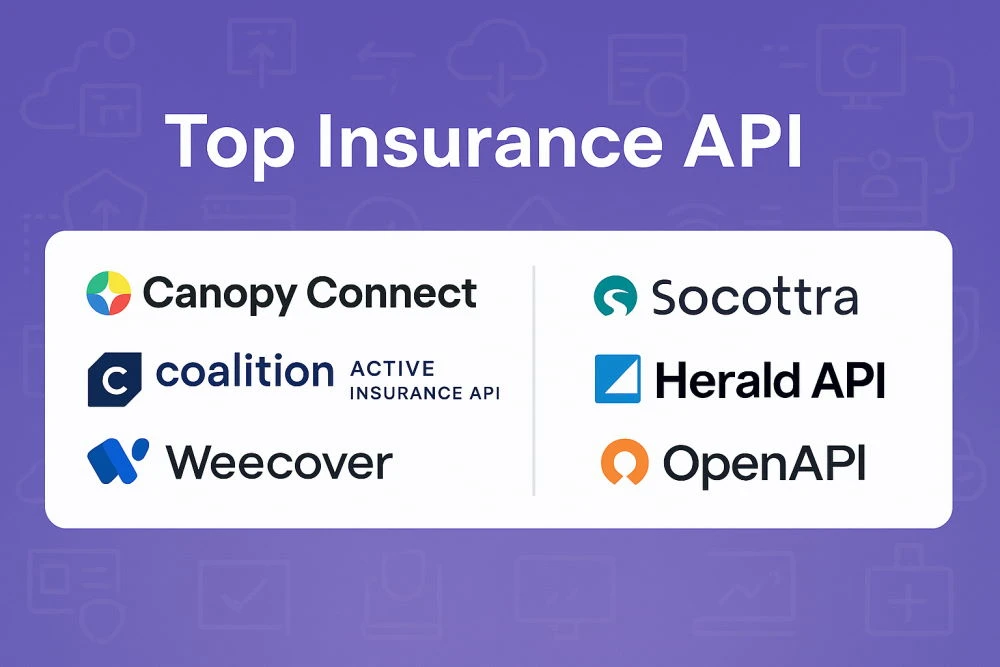 Policy Management
Policy Management